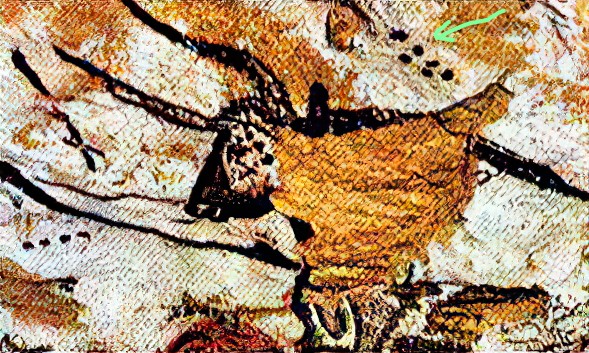|
15,000
Year Old Lunar Calendar Identified with Pleiades Star Cluster

By BBC
News Online science editor
Dr David Whitehouse in France
Monday, 16 October, 2000, 22:27 GMT 23:27 UK
What could be the
oldest lunar calendar ever created has been identified on the walls of
the famous, prehistoric caves at Lascaux in France.
The interpretation
that symbolic paintings, dating back 15,000 years, show the Moon going
through its different phases comes from Dr Michael Rappenglueck, of the
University of Munich.
The German
researcher has previously associated patterns left in the caves with
familiar stars and constellations.
He now says groups
of dots and squares painted among representations of bulls, antelope and
horses depict the 27-day cycle of the Earth's satellite.
Works of art...
With special
permission from French authorities, I went into the Lascaux caves with
Dr Rappenglueck to inspect the paintings for myself. It was an
opportunity most people would never get - to protect the historic site
from unnecessary wear and tear, all visitors now tour a mock-up of the
caves, the so-called Lascaux II.
"The secret of
understanding these caves," Dr Rappenglueck told me as we descended
into the dark, "is to understand the people who painted these
walls.
"They painted
the sky, but not all of it. Just the parts that were specially important
to them."
With eyes becoming
adjusted to the half-light, I entered the Chamber of the Bulls and stood
there in amazement. Anyone who has seen the paintings on the walls can
be left in no doubt that they represent some of the greatest works of
art every created.
The animals were
painted on to the walls of the chamber by Cro-Magnon man, one of our
close relations, 15,000 years ago. He thrived in a temperate valley in
the Dordogne while the rest of Europe was held in the grip of an ice
age.
As I marveled at the
spectacle, Dr Rappenglueck moved ahead of me.
"Here it
is," he said, as he headed down the passage. He was pointing to a
line of dots painted half way up the wall. "Count them. Count
them."

Below a stunning
painting of a deer was a row of 13 dots, ending in a square. "Why
13?" I ask.
"It's half of
the Moon's monthly cycle," Dr Rappenglueck said. "One dot for
each day the Moon is in the sky. At the new Moon, when it vanishes from
the sky, we see an empty square, perhaps symbolically representing the
absent Moon.
"But there's
more, further along." The Munich researcher gestured to me to move
along the passageway. Beneath a dappled, brown horse with a dark mane
was another row of dots. This time there were more of them.
"There are 27
of them - one for each day of the Moon's 27-day cycle when it runs
through its phases in the sky. It was a rhythm of nature that was
important to these people."
Dr Rappenglueck
looked around at the bulls, antelope and horses painted on the walls
with such obvious admiration. "They were aware of all the rhythms
of nature. Their survival depended on them, they were a part of
them."
The Pleiades star
cluster sits above the bull's shoulder...

But there is another
puzzle. I pointed to the series of dots that curve away from the main
row. "Why do they do that?" I enquired.
"I think that
indicates the time of the new Moon, when it disappears from the sky for
several days," said Dr Rappenglueck.
There is definitely
astronomy on the walls of Lascaux. Earlier this year, Dr Rappenglueck
identified a series of constellations painted on the wall of a shaft off
the main chamber at Lascaux. The
tiny pattern of the Pleiades star cluster can also be seen hanging above
the shoulder of a bull near the entrance to the main passageway.
We will probably
never understand completely what Cro-Magnon man had in mind when he
painted the Lascaux caves. The images of the animals seem obvious but
what are we to make of the geometrical shapes and patterns scattered in
between these creatures?
Something
to think about... Our
best scientists tell us that 15,000 years ago our ancestors were primitive
bushmen trying to figure out how many toes they had on their feet. -
Why did our ancestors draw these kinds of pictures?
- Did they draw these pictures?
- Why of the Pleiades of all stars and star systems?
- Is the bull in the picture a representation of the
constellation Taurus?
- Did our ancestors have help drawing the pictures?
- Who might have given them help?
- Why don't the establishment scientists ask these
kinds of questions?
- What are they afraid of?
- Is it possible off-Earth visitors had something to do
with it?
- Why is the establishment so afraid to acknowledge
this
possibility? have given
Ancient Civilization Index
E-Mail
Home
|